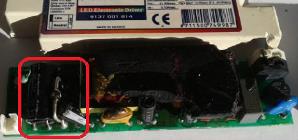LED components can be designed and selected to offer reliability and long life. However it is also critical to consider the lifetime of the power supply unit, can this support and match the lifetime of the LED? Many LED users are unaware of the de-facto industry standard for driver failure: 0.2% per 1000 hours. So how do you build this into design considerations and product life expectations?
The three key factors affecting driver performance are:

Electronic products can be extremely reliable but ‘you get what you pay for’. In terms of value for money if you shift from price to performance and understand that the current industry rate is 0.2% per 1000 hours de-facto standard for lighting electronics, the quality of the electronic products you select and purchase has a direct impact on product life and LED performance. Always check manufacturer’s technical specifications for driver lifetime value and failure rates.
The lifetime of a driver is determined by the lifetime of its individual components. Factors affecting key component lifetime include:
Failure in any one can cause the lights to go out, flickering and EMC non-compliance etc.
Ineffective or faulty soldering can cause a driver/PSU to fail. Causes of poor soldering include low operator skill, poorly controlled manufacturing processes and quality assurance procedures. Again this can impact on a driver by causing the lights to go out. Prevention is pretty simple: control your manufacturing to the Electronic Industry’s ‘bible’ of soldering IPX-A-610-E!
Here’s a check list to help prevent driver/PSU failure:
Driverless LED light engines are PCBs that don't require the use of a power supply, ballast or control gear to enable them to operate successfully. For example, a driverless mains powered light engine can be connected directly to a 230V AC supply. For more information contact our sales team to find out more.


